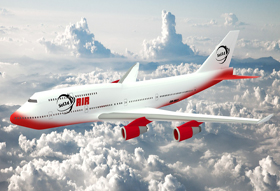
Foam for aircraft innovation

Innovation in the foam sector is ongoing, and as time goes on, the capabilities of foam are being noticed in several new industries and applications. However, significant research is also underway in sectors that already use a wide range of foam products. Despite some of the incredible work that is being undertaken in extraordinary settings – such as in space – detailed research is also underway in sectors such as aviation.
Given that environmental considerations are rightfully at the top of the agenda, the aviation industry is seeking new ways to help cut its carbon emissions. As it is difficult to encourage a natural reduction in air travel in our modern world, the industry is working on a different approach. Notably, this comes in the form of making commercial planes more lightweight to reduce the quantity of fuel that burns over a given distance.
Over many years, there have been significant developments in the types of foam that are used in commercial upholstery, for example. This includes the creation of specialist foams that are purposely designed to meet safety and regulatory standards for commercial vehicles. Additionally, these foams are becoming increasingly lightweight, but up until now, details on these materials have been scarce.

In the aviation industry, several types of foam are making their way into new aircraft. For many years, aviation materials have needed to adhere to a number of standards, including requirements concerning thermal, fire, toxicity and smoke performance. However, new standards also assess aircraft materials and components based on their weight-saving credentials. As of late, some UK-based manufacturers have recognised the capabilities of fire-retardant closed-cell polyethylene (PE) and polyvinylidene fluoride (PVDF) for their lightweight, fire-resistant qualities that make them suitable contenders for aircraft.
In many manufacturing processes, chemicals are used to expand foam to achieve the pocket-like honeycomb structure we are familiar with. However, the key to the new and improved performance of these foam materials stem from the manufacturing process itself. To give polyethylene (PE) and polyvinylidene fluoride (PVDF) foams their distinct shape and fire retardance, without the addition of other weighty chemical components, nitrogen gas is used to expand the material. Nitrogen is known for its fire resisting chemical composition.
The most versatile and popular ‘new’ foam is PVDF as it is known for its weight reduction of up to 50% in comparison to silicone. In new and refurbished aircraft, PVDF is used for trimmings, insulation, carpet underlay and window seals, and is slowly being implemented in other interior aspects such as overhead bins, tray tables and armrests. In some testing environments, the use of PVDF has shown to reduce weight by up to 70% compared to the previous materials.
As the aviation industry becomes increasingly competitive and as environmental concerns and penalties rise, experimentation with foam materials is increasingly commonplace. PVDF, polyethylene foams and nylon foams are now at the forefront of innovation, with conventional materials now on their way out. The aviation industry is no longer focusing on the design and engineering of the outer aircraft but on the cost and efficiency savings that can be made to interior structures. We are pleased to see the versatility of foam being recognised in such an essential part of modern travel.

